
Rich snippets are an essential component of search engine optimization (SEO) for industrial manufacturing retailers. Rich snippets help industrial manufacturing retailer’s product, article, general web pages and search results stand out in the search engine results pages (SERPs), and better their chances of higher click through rates (CTRs) and engagements. Rich snippets are a great SEO tool for small business industrial manufacturers because it highlights your page results and separates you from your competitors.
If you’re an industrial manufacturing retailer, having rich snippet results will increase your small business’ visibility and increase the chances of your result being ranked higher so more searchers will see it. That’s definitely a goal for all small business retailers, let alone niche, industrial manufacturing retailers who may find it difficult to create and retain a steady stream of leads and customers.
In this article, I’ll explain more of what an SEO “rich snippet” entails and how you can create them to increase your chances of moving up in the search results.
Let’s get started!
What Are Rich Snippets?
Ok, so what are “rich snippets”. Basically, “rich snippets” are search results that have been optimized by including more essential information right in the SERP result. A regular “snippet”, for example, may only include the page headline, URL, and the meta description. A “rich snippet”, on the other hand, would include all that plus images, product reviews, a Google map location etc. A rich snippet will include more specific data that can give the search engine and the searcher more information from the get-go on how to better understand your search result, as it pertains to the results yours is competing against in the SERPs.
The more structured data you have optimized in your search result, the “richer” it becomes.
This is Google’s definition: “Rich snippets (html code) are designed to summarize the content of a page in a way that makes it even easier for users to understand what the page is about in our search results.”.
So based on the definition above, which one of the following listings for the same company would be an example of a rich snippet? #1, #2, or #3?
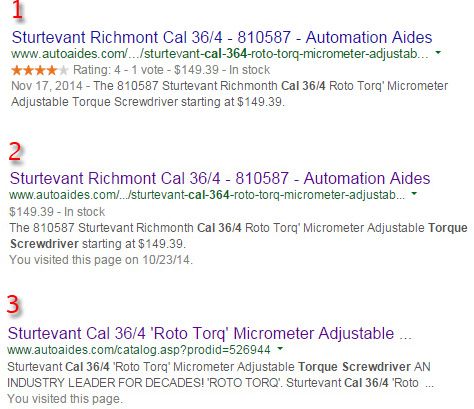
This was a bit of a trick question. The answer is #1 AND #2.
Both #1 and #2 have more structured data information added to the result than the #3 option. #1 is the example with the product rating and #2 is an example without the product rating, but still showing some product information. However, you do want to shoot for the result that contains the most information possible, so option #1 should be the target.
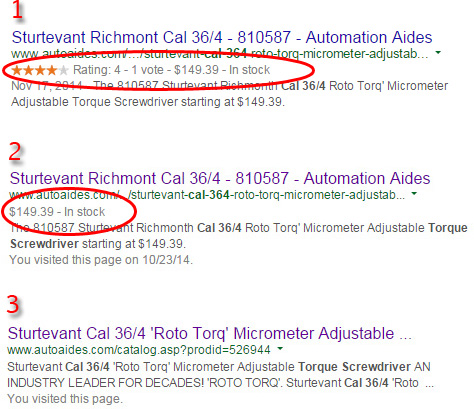
Why You Need Rich Snippet Results as an Industrial Manufacturing Retailer
There are some great benefits of having search engine optimized rich snippet results in SERPs, especially for niche industrial manufacturers.
Rich snippets are a beneficial SEO technique for a variety of different types of web pages including:
- Reviews
- People and employee pages
- Products pages
- Events
- Blog articles
Odds are, your target audience and customers are using specific terms when they perform a Google search. They’re using terms or particular product names to find what they’re looking for when they’re ready to buy from an online ecommerce site. So the SEO techniques you use for your industrial manufacturing small business need to be specific as well. As an industrial manufacturing retailer, you can take that knowledge of their search behavior and provide rich snippet results for your specialty products so your target audience can find you more easily.
Rich snippet results can cause higher levels of CTR and engagement from online searchers, which often leads to high purchase rates and annual revenue for those companies. Online searchers will feel more reassured and convinced to click on a rich snippet result (as compared to a regular snippet result) because more information is visible to them. If a searcher can clearly see the product review rating and price for say an industrial weighing scale, before they actually click on the result, they’ll be more likely to do so.
Remember, online searchers want to find what they’re looking for quickly. They don’t want to click through a whole list of results to find what they’re looking for. If your search result is optimized to include valuable product data, that cuts down on their search time and makes your rich snippet result stand out from the rest in the SERPs too. Industrial manufacturing SEO work will help you with this.
You’re giving online searchers the info they want quickly, and as a result, your result will most likely gain the most clicks. Everybody wins.
How to Create Rich Snippets for Your Industrial Manufacturing Web Pages
There are a few options you have when it comes to using schema markups on your website to create rich snippets in the search results.
1. Rich Snippet WordPress Plug-ins
WordPress (WP) is the most popular website builder platform out there. For small businesses, it’s a great options because it’s fairly simple to use and manage. If you have a WordPress website and ecommerce site for your industrial manufacturing business, there are WP compatible plugins you can use to make your schema markup and rich snippet creation easier. Having a plugin to do the schema markup work for a specific product or other page will end up saving you a lot time in the long run, especially if you’re not familiar with code or more advanced SEO techniques.
Some WordPress integratable schema markup plugins you can download are:
- Schema Pro
- WP Review Pro
- All in one Schema.org
There are many other schema markup plugins you can download at various price points, so do some research into features you want particularly first.
2. How to Do a Schema Markup Yourself
A scheme markup is basically how you’ll tell Google what everything on your page is and how you’d like it interpreted. Schema markups help search engines index web pages more efficiently to provided fully optimized search results (rich snippets).
To start off, you’ll need to use Google’s Structured Data Markup Helper to help you.
Step 1: Use Google’s Structured Data Markup Helper
Once you get to the main page of Google’s Structured Data Markup Helper, you need to select what type of page you want to markup (for this example, I’ll be marking up an article page because we have a large amounts of blog articles on the Cazbah site) and then include the page URL or HTML for that page in the box provided. Once you’ve done that, click the blue “Start Tagging” button.
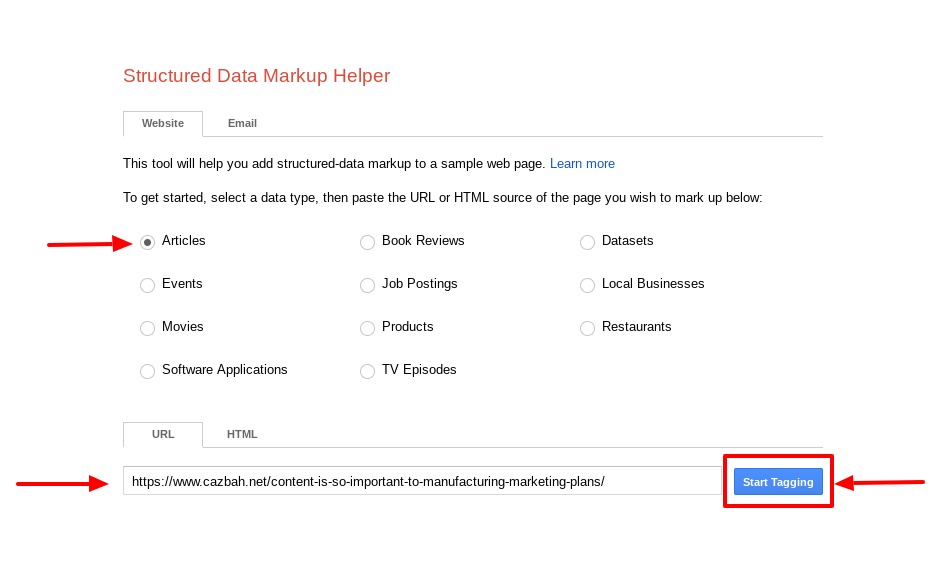
Step 2: Tagging Your Web Page
Now begins the actual process of doing your schema markup page work. Once the new window has loaded, you’ll see the webpage you loaded on the left and Google’s schema markup tagging window on the right. You want to fill as many of those information sections in the tagging window as possible to best markup your web page or product page.
To do this, highlight a particular section of your web page on the left and then click on what you highlighted. When you do, a drop down box will appear giving you options to assign what you selected. Once you select the tagging option you want, it will automatically populate in correct section in the right hand Google tagging window on your screen.
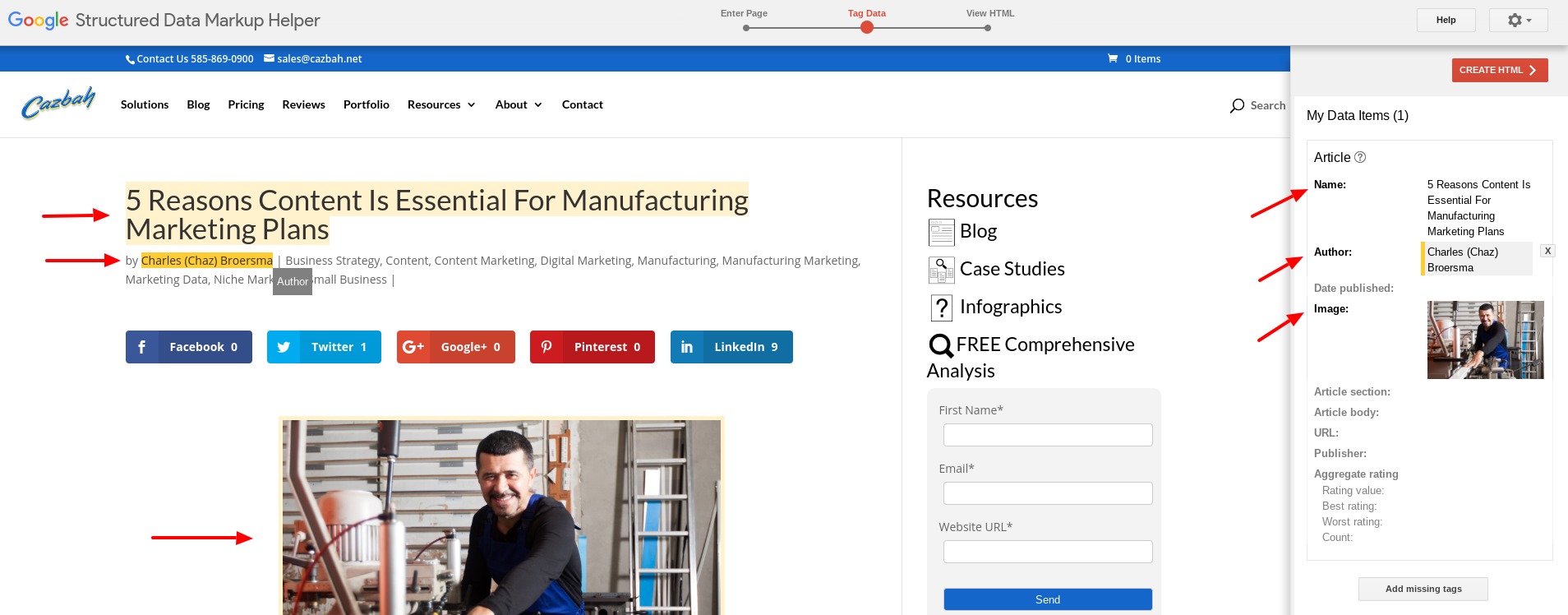
As you can see in the image above, I started with the article name and continued to work my way down the article.
Step 3: Download Your HTML Code
Once you’ve tagged everything you can, select the red “Create HTML” button on the upper right hand corner of the right hand side Google tagging window. When you do, you HTML code will appear including the schema markup data you tagged beforehand. From there, click the “Download” button to access the HTML code file and then click the “Finish” button.
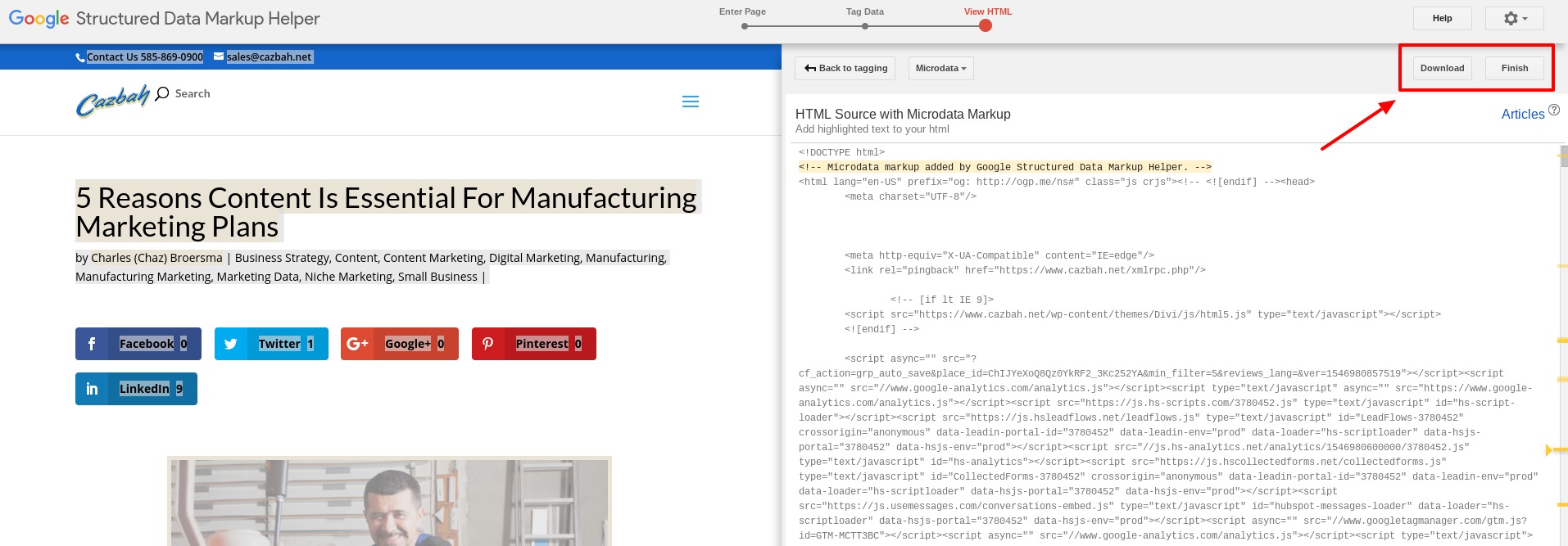
Step 4: Use Google’s Structured Data Testing Tool
Once you’ve clicked the “Finish” button, now it’s time to test how your web page result will appear in a Google Search. To do that, use Google’s Structured Data Testing Tool. You will be brought to a new window that looks like this:
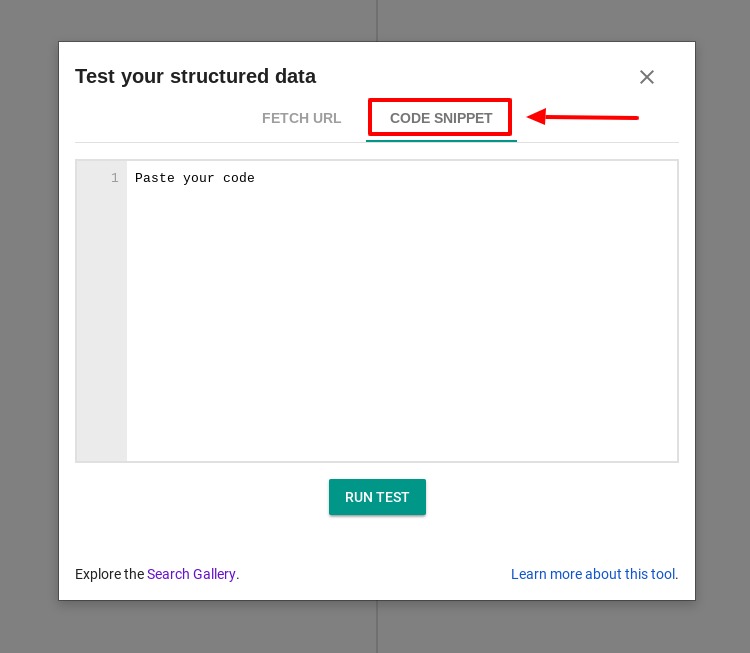
Make sure you select the “Code Snippet” option and paste the code that you downloaded previously into the space provided. Then run the test. If you have any errors present in your page, they will be noted in a new window and you’ll have the ability to see what those errors are, so you can go back and fix them in your schema markup.
Step 5: Test How Your Rich Snippet Appears in SERPs
You want to view your search result to see how well optimized it will appear in SERPs and if it will truly appear as a rich snippet. There should be a category option that will come up in the new right hand window titled “Article” (this will pertain to the page type you selected back in step #1). Click that option. Once there, click the green “Preview” button. This will show you all the ways your page result could possibly appear in the results pages.

It’s important to review every result for your page, so you can make sure each one is displayed properly no matter what form it takes.
And that’s it! Now you can rest easy knowing that your industrial manufacturing product, article, review etc. web pages are fully functional, optimized, and effective in gaining your small business website traffic in the search results pages.
In Conclusion
Rich snippets are a powerful SEO tool for industrial manufacturers you can use to better optimize how your search result appears in SERPs, and will increase your chances of searchers actually clicking through and engaging with your content. Performing a schema markup on your small business industrial manufacturing web pages will increase their visibility in search results, thereby increasing your ability to connect with valuable leads in your target audience.
